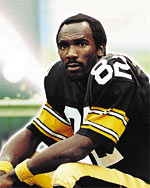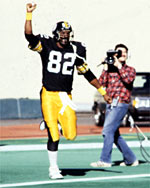John Stallworth (continued)
"It was a really tough time for me," he recalled. "It was psychologically damaging. If it hadn't been for my wife and friends, I couldn't have gotten through it." Though frustrated, Stallworth never doubted that he had the necessary tools to be a star in the NFL. His strength of character, mental toughness, and competitive nature kept him focused.
 |
Stallworth could no longer be looked at as an emerging star. He had arrived. And in 1979, his star shined brightly as he set a new team record with 70 receptions good for 1,183 yards. As if to add an exclamation point on the season, he again capped it off with playoff heroics. In Super Bowl XIV he caught three passes for 121 yards and a touchdown. The touchdown - a 73-yard beauty in which he picked the ball off his facemask while falling backwards - proved to be the game-winning score. His outstanding season-long performance earned him All-Pro and All-AFC honors and the first of four Pro Bowl berths. It also earned him the ultimate recognition from his teammates as they selected him their Most Valuable Player.
Stallworth was a "big game performer" and was one of just a handful of Steelers to play in each of the team's four Super Bowl victories. As of 2002 when he was elected to the Hall of Fame, John was tied for or held four Super Bowl receiving records and held four post-season records.
In addition to finally earning well-deserved national recognition, Stallworth had also clearly earned the respect and confidence of his teammates including quarterback Bradshaw. Early on, while Stallworth was sharing time at wide receiver with Frank Lewis, Bradshaw tended to look more often in Swann's direction. But that all changed as John emerged from the shadows of both Lewis and Swann. His emergence, however, inevitably caused observers to compare Swann and Stallworth.
While competitive, the two young receivers developed a good rapport with each other. "The rivalry doesn't get to the point where it's a jealousy type thing," Stallworth explained when asked in 1979. "I think we both have big egos, but we're able to subdue them a little bit for the team effort."
But the two definitely competed. "A lot of times we weren't competing against the opposing team," he once lightheartedly confessed. "We were competing against each other to see who'd catch the most passes. To see who'd make the great move to get open, that we could look at later (on film) and say 'Oooooh'."
Getting open was something Stallworth seemed to do with ease. Time and again he would reach over a defender to pull down a pass and then just out-muscle and maneuver his way down field.
The Bradshaw-to-Stallworth combination grew as the two All-Pro performers developed a strong comfort zone. Stallworth's blend of deceiving speed, soft hands, and perfect pass patterns made him a Bradshaw favorite. He even perfected a new move - the hook slide catch - a move he used frequently in pressure situations.
"It's my own invention," Stallworth told a reporter. "I don't know why I started to do it, it just sort of happened."
As rewarding as the 1979 season was for Stallworth, the 1980 season brought only angst and disappointment as injuries (a cracked fibula and later a broken bone in his foot) limited his play to just three games.
Still hobbling at the start of the 1981 season, there was some question as to how effective he might be. When he opened the season with an impressive 3-catch, 82-yard performance that included a 56-yard grab and a five-yard touchdown reception, coach Chuck Noll was all smiles. "He's good," laughed a relieved Noll. "Even when he limps." Stallworth finished the season with 63 receptions for 1,098 yards.
 |
Just as Stallworth had emerged an elite receiver in the NFL, his peers recognized him for his leadership and dedication to the game. At times, his on-the-field accomplishments were overshadowed by his inspirational hard-fought comeback battles from nagging leg injuries. His most impressive demonstration of his work ethic and determination to succeed came in 1984.
After missing much of the 1983 season due to injury, some observers began to suggest that John's most productive days were behind him. "A remnant of an empire, an artifact from kingdoms past," was how one writer described him prior to the start of the 1984 season.
"I knew better than that," Stallworth said. "I knew that I could come back and have a very good season if I was healthy." That year, at age 32, he not only had a "very good season," he had his greatest season ever, catching 80 passes for an AFC-leading 1,395 yards and 11 touchdowns - and all without Bradshaw, who had retired. It was a banner year, one in which he shattered five team records and was named the NFL Comeback Player of the Year.
Stallworth's performance may have been a surprise to some observers, but not for the future Hall of Famer. "I felt I had the talent and could still play the game," he professed. "As you get older you have to do more things to maintain your health. The key to returning to form was good health."
For Stallworth, returning to good health meant altering his workouts, concentrating on leg strength. It was an adjustment that worked, as he ran the fastest 40 time since his rookie year. Stallworth's "comeback" continued for three more seasons, during which he averaged 50 receptions per year.Finally, following the 1987 season, the soft-spoken former fourth -round pick out of Alabama A&M announced his retirement.
"My goal when I came to the NFL was to gain the respect of my peers and a certain amount of self respect," he once remarked. "I was never really interested in publicity or notoriety." Twice selected as his team's Most Valuable Player and four times named to the Pro Bowl, is evidence enough of the respect his peers felt for him. And, his election to the Pro Football Hall of Fame in 2002 assures him of the notoriety he so often shunned but unequivocally deserves.
Top 20 - start of 2002
John Stallworth: Class of 2002
Steelers Hall of Fame wide receiver was added to the team's ownership.

